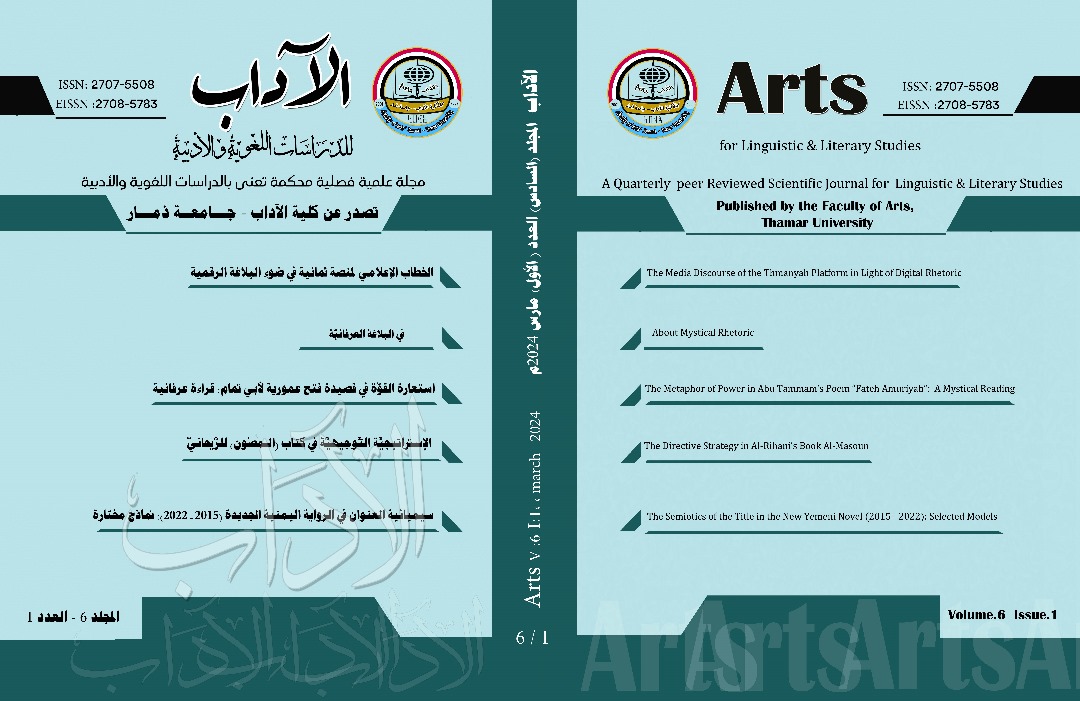The Centrality of Women in Muhammad Ibrahim Yaqoub’s Collection ‘Hafat Sabi’a’: A Psychological Study
DOI:
https://doi.org/10.53286/arts.v6i1.1786Keywords:
Center and Margin, Women's Issues, Deprivation Complex, PsychoanalysisAbstract
This research presents a psychological analysis of the motivations for the centrality of women according to the poet Muhammad Ibrahim Yaqoub in his collection ‘Hafat Sabi’a’ (The Seventh Edge) and aims to explain the heavy presence of the poem on the lips of women in the collection, and the secret of the poet’s self-hiding behind the other (the center). The research was divided into two sections: first: the marginalization of the self, and second: women’s sovereignty (the center). To reveal the inner self, we relied on psychological reading with the help of psychoanalysis. The research concluded with the following results: the link between women’s rejection of stability and the anxiety of the poet’s self, in an attempt by the poet to abolish the inherited ideas about women’s subordination to men. The researcher also identified the most important psychological reasons for the lack of security, which formed the history of the poet’s childhood complex; Thus, the woman occupied the center circle in causing anxiety, and the poet sided with the margins.
Downloads
References
إسماعيل، عز الدين. (1981). الشعر العربي المعاصر قضاياه وظواهره النفسية والمعنوية (ط.3). دار العودة.
ألفريد، آدلر. (2009). الطبيعة البشرية، (عادل نجيب بشري، ترجمة) (ط.2). المركز القومي للترجمة.
ألفريد، آدلر. (2005). معنى الحياة، (عادل نجيب بشري، ترجمة)، (ط.1). المجلس الأعلى للثقافة.
باريك، بيكو. (2013). سياسة جديدة للهوية، (محمد حسن، ترجمة) (ط.1). المركز القومي للترجمة.
بيرجر، بيترل، ودوجلاس، وفوكو، ميشيل، وهابرماس، يورجين. (2009). التحليل الثقافي، (فاروق أحمد، ومرفت العشماوي، ومحمد حافظ، ونادية أحمد، وهندومة محمد أنور، ترجمة)، الهيئة المصرية للكتاب.
صفر، شيماء نجم. (2013). تشظي الذات وتحلل الشخصية وعلاقتها بالكرب النفسي، المكتب الجامعي الحديث.
عبد المطلب، محمد. (2008). ذاكرة النقد الأدبي (ط.2). المجلس الأعلى للثقافة.
عكاش، عمار. (2005). صورة المرأة في الشعر العربي المعاصر، الحوار المتمدن، (1131): https://www.ahewar.org/debat/show.art.asp?aid=33170
عويضة، كمال محمد. (1996). مشكلة الطفل، دار الكتب العلمية.
فرويد، سيجموند. (1982). الأنا والهو، (محمد عثمان نجاتي، ترجمة) (ط.4). دار الشروق.
فرويد، سيغموند. (1975). التحليل النفسي والفن: دافنشي دوستويفسكي، (سمير كرم، ترجمة) (ط.1). دار الطليعة للطباعة والنشر.
فرويد، سيجموند. (2017). الغريزة والثقافة: دراسات في علم النفس، (حسين الموزاني، ترجمة ط.1). منشورات الجمل.
كلر، جوناثان. (2018). مطاردة العلامات: علم العلامات، والأدب، والتفكيك، (خيري دومة، ترجمة ط.1)، المركز القومي للترجمة.
ليمان، جنيفر. م.( 2013). تفكيك دور كايم: نقد ما بعد بعد بنيوي، (محمود أحمد، ترجمة ط.1)، المركز القومي للترجمة.
ماكلو، ميشيل، وبارجمنت، كينث آ.، وثورسين،كارل. (2015). التسامح (النظرية والبحث والممارسة)، (عبير محمد أنور، ترجمة) (ط.1). المركز القومي للترجمة.
ويتمر، باربرا. (2007). الأنماط الثقافية للعنف، (ممدوح يوسف، ترجمة)، المجلس الوطني للثقافة والفنون والآداب.
يعقوب، محمد إبراهيم. (2020). حافة سابعة، النادي الأدبي بالطائف (ط.1). الانتشار العربي.
Reference
Ismāʻīl, ʻIzz al-Dīn. (1981). al-Shiʻr al-ʻArabī al-muʻāṣir qaḍāyāhu & ẓawāhiruhu al-nafsīyah & al-maʻnawīyah (3rd ed.). Dār al-ʻAwdah, (in Arabic).
Alfred, Adler. (2009). al-Ṭabīʻah al-basharīyah, (ʻĀdil Najīb Bushrá, tarjamat) (2nd ed.). al-Markaz al-Qawmī lil-Tarjamah, (in Arabic).
Alfred, Adler. (2005). Maʻná al-ḥayāh, (ʻĀdil Najīb Bushrī, tarjamat), (1st ed.). al-Majlis al-Aʻlá lil-Thaqāfah, (in Arabic).
Parekh, Bhikhu. (2013). Siyāsah jadīdah lil-huwīyah, (Muḥammad Ḥasan, tarjamat) (1st ed.). al-Markaz al-Qawmī lil-Tarjamah, (in Arabic).
Berger, Petrel, Douglas, Foucault, Michel, and Habermas, Jürgen. (2009). al-Taḥlīl al-Thaqāfī, (Fārūq Aḥmad, & Mirfat al-ʻAshmāwī, & Muḥammad Ḥāfiẓ, & Nādyah Aḥmad, & Handwmah Muḥammad Anwar, tarjamat), al-Hayʼah al-Miṣrīyah lil-Kitāb, (in Arabic).
Ṣafar, Shaymāʼ Najm. (2013). Tashaẓẓī al-dhāt & taḥllul al-shakhṣīyah & ʻalāqatuhā bi-al-karb al-nafsī, al-Maktab al-Jāmiʻī al-ḥadīth. https://www.ahewar.org/debat/show.art.asp?aid=33170, (in Arabic).
ʻAbd al-Muṭṭalib, Muḥammad. (2008). Dhākirat al-naqd al-Adabī (2nd ed.). al-Majlis al-Aʻlá lil-Thaqāfah.
ʻAkkāsh, ʻAmmār. (2005). Ṣūrat al-marʼah fī al-shiʻr al-ʻArabī al-muʻāṣir, al-Ḥiwār al-Mutamaddin, (1131) : https://www.ahewar.org/debat/show.art.asp?aid=33170, (in Arabic).
ʻUwayḍah, Kamāl Muḥammad. (1996). Mushkilat al-ṭifl, Dār al-Kutub al-ʻIlmīyah, (in Arabic).
Freud, Sigmund. (1982). al-Anā al-Huwa, (Muḥammad ʻUthmān Najātī, tarjamat) (4th ed.). Dār al-Shurūq, (in Arabic).
Freud, Sigmund. (1975). al-Taḥlīl al-nafsī & al-fann, Da Vinci – Dostoyevsky, (Samīr Karam, tarjamat) (1st ed.). Dār al-Ṭalīʻah lil-Ṭibāʻah & al-Nashr, (in Arabic).
Freud, Sigmund. (2017). Al-Gharyzah & al-Thaqāfah: Dirāsāt fī ʻilm al-nafs, (Ḥusayn al-Mawzānī, tarjamat) (1st ed.). Manshūrāt al-Jamal, (in Arabic).
Culler, Jonathan. (2018). Muṭāradat al-ʻAlāmāt: ʻilm al-ʻalāmāt, & al-adab, & al-tafkīk (Chasing signs: semiotics, literature, and deconstruction), (Khayrī Dūmah, tarjamat) (1st ed.). al-Markaz al-Qawmī lil-Tarjamah, (in Arabic).
Lehmann, Jennifer M. (2013). Tafkīk Durkheim: Naqd mā baʻda baʻda binyawī, (Maḥmūd Aḥmad, tarjamat) (1st ed.). al-Markaz al-Qawmī lil-Tarjamah, (in Arabic).
McCullough, Michael E., Pargament, Kenneth I., and Thoresen, Carl E. (2015). al-Tasāmuḥ (al-naẓarīyah & al-baḥth & al-mumārasah), (ʻAbīr Muḥammad Anwar, tarjamat) (1st ed.). al-Markaz al-Qawmī lil-Tarjamah, (in Arabic).
Whitmer, Barbara. (2007). al-Anmāṭ al-Thaqāfīyah lil-ʻunf, (Mamdūḥ Yūsuf, tarjamah), al-Majlis al-Waṭanī lil-Thaqāfah & al-Funūn & al-Ādāb, (in Arabic).
Yaʻqūb, Muḥammad Ibrāhīm. (2020). Ḥāffah Sābiʻah, al-Nādī al-Adabī bi-al-Ṭāʼif (1st ed.). al-Intishār al-ʻArabī, (in Arabic).
Downloads
Published
How to Cite
Issue
Section
License

This work is licensed under a Creative Commons Attribution 4.0 International License.
Copyright and Licensing
copyright is retained by the authors. Articles are licensed under an open access Creative Commons CC BY 4.0 license, meaning that anyone may download and read the paper for free. In addition, the article may be reused and quoted provided that the original published version is cited. These conditions allow for maximum use and exposure of the work.



